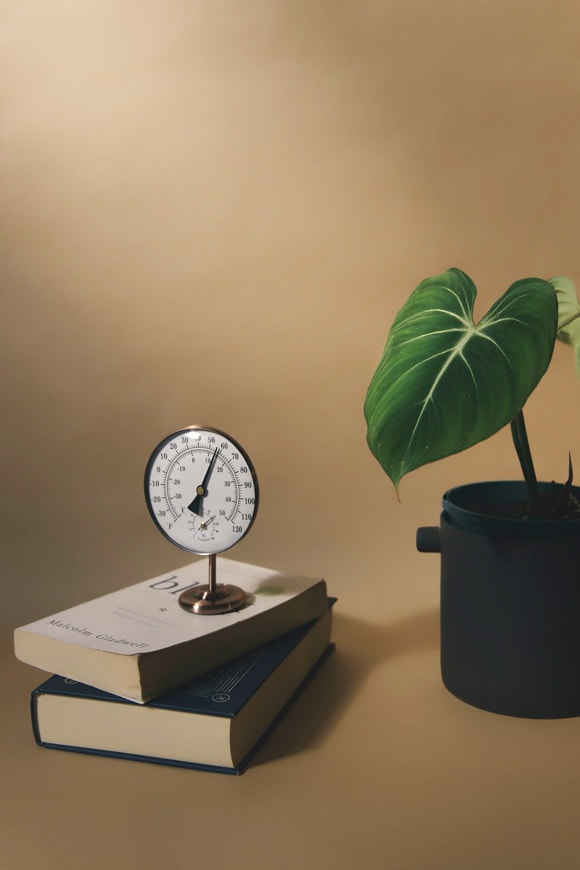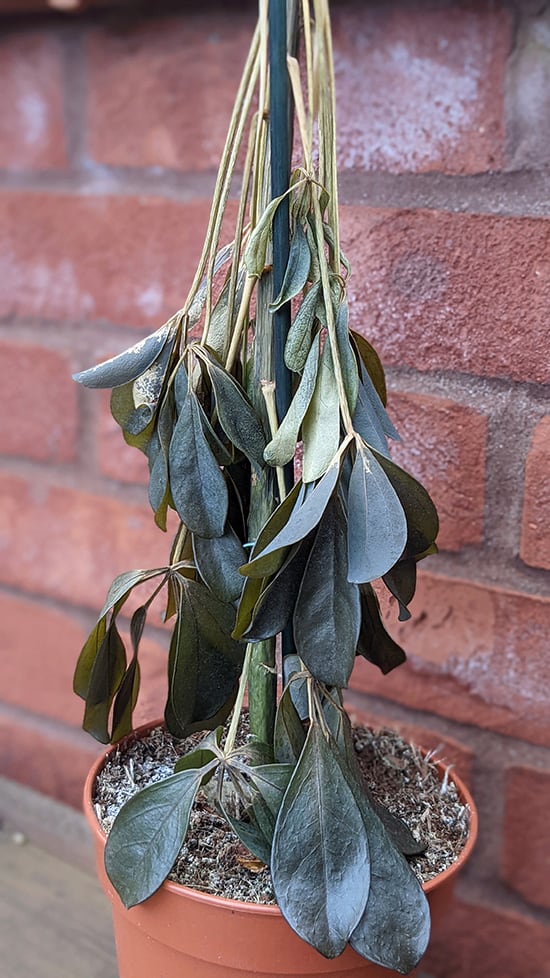Plants will generally grow faster when the temperature is warmer and slow down when it gets cold. There is a fine balance to getting it right, but most houseplants are adaptable and will go with the flow, so don't worry too much about getting it perfect.
Temperature is an easy topic to get right most of the time. If it's too hot or too cold for us, then it's more than likely the same story for our houseplants.
Do you have high temperatures or low temperatures in your growing spaces? A good way to monitor temperature is by using a gauge or thermometer - photo by gryffyn m
The general rule to follow is that when the plant is growing it needs to be relatively warm, and when it's resting (normally in the Winter) it likes a cooler temperature.
Very few houseplants (if any) like very cold conditions and even the briefest exposure to frost can be fatal to tropical plants. As with everything to do with plants there are exceptions and if you want to know the exact range for your particular specimen, head over to the Plant Hub.
The rest of this guide explores these concepts in more detail, so let's get going.

Hi, I'm Tom!
If you're like me and enjoy the challenge of growing houseplants and getting them to thrive, then Ourhouseplants can help. This website shares my knowledge and years of growing plants and provides (hopefully) helpful advice on properly caring for your indoor plant friends.
What would you say if I asked you what's the lowest temperature for house plants?
Some people would say anything close to freezing, which is 0°C (32°F). But that's not actually correct, at least for many houseplants anyway.
The majority of indoor plants originate from warm tropical regions in the world. This means they would rarely experience sub zero temperatures in nature or anything close to it and as a consequence they're not adapted to dealing with cold temperatures.
Put simply; they don't like it.
What temperature does frost occur on plants?
Did you know you don't need freezing temperatures for a frost to happen? Anything below 2.2°C (36°F) can cause one.
This will be devastating for the majority of houseplants. Although they may rebound, the foliage is likely to be seriously damaged.
Some will cope with the cold of course, but others will suffer as soon as the temperature creeps below 10°C (50°F).
Other plants, especially tropicals, will become unhappy if things dip below 15°C (59°F) for long periods. They have low temperature tolerance.
You might get away with hot temperatures for a while, but plants are often less forgiving if things turn cold for any significant length of time.
Thankfully most homes will not experience very chilled indoor temperatures like this, but if you have put your houseplants outdoors during the Summer, be sure to bring them back inside before the first frost.
Even a small overnight frost or freeze can turn your prized specimen into a mushy slimy mess overnight.
Similar advice applies when buying plants in the winter months. Only keep them outside in the elements for as short a period as possible and don't leave them in your cold car.
They're not made of glass though, and most can easily deal with five minutes or so outside, so if you need to repot in winter... you can (within reason).
Okay, so you're not sure if you're houseplant is suffering from the cold. What are the signs to look out for that your plant is too cold?
Any of the following could indicate cold damage from exposure to lower temperatures.
This has to be a generic response because so many houseplants have different needs. But most houseplants will be able to deal with higher temperatures up to 35°C (95°F) without too much fuss provided they've been well watered, and it only happens temporarily..
Extreme heat will often cause plants to wilt and they'll pause their photosynthetic functions. Essentially they shut down to protect themselves from damage until the heat passes.
Are fans a good way to cool plants down?
Fans will move the air around the area providing ventilation. For humans this can have a pleasant "cooling" feeling. But it doesn't actually lower the temperature.
For plants, this breeze increases the rate of transpiration (water loss) from the leaves. Not helpful at all and will just speed up the wilting process.
Some will have a higher temperature tolerance and will take considerably more heat for longer, especially succulents and cacti.
High humidity levels also help reduce water use and foliage plants will cope better in these growing environments if things are hot.
But many others will start to struggle if the temperatures get hotter or if it's a low humidity situation.
Arguably hot temperatures are likely to be less damaging than cooler temperatures, but it will still cause stress to your plants and it's likely to have negative consequences in the long term.
If the potting medium runs dry then serious damage is just around the corner if you leave them in the heat and you don't water them quickly.
Some plants don't respond well to heat at all. For example, those we buy over Winter like Hyacinths and Poinsettias, will really struggle in hot rooms. Even ideal temperatures above 21°C (70°F) can cause issues for them, like falling leaves, unusual growth and shortened flowering periods.
What are the signs to look out for that your plant is too hot and suffering from heat stress?
The following could indicate heat damage from exposure to extreme warmer temperatures.
Although it varies between plants, the optimum temperature for plant growth is generally considered to be somewhere between 21°C (70°F) and 27°C (80°F). Most plants are adapted to grow best in this temperature range.
This isn't a target temperature though. It might be considered the "best" for most, but many plants will still grow even outside of this ideal range, just a little slower.
This is good news for plant owners, because generally our homes are likely to have spaces that provide this "optimal" temperature all year round. Or at least close to them.
There are exceptions to this, for example plants like Marimo (Moss Balls), and English Ivy would actually prefer things to be cooler. Meanwhile, certain succulents really need that top end of the range or even hotter for them to grow really well.
So even if you're home doesn't fit the "norm" there will still be a good range of plants you can choose from that will grow well in your conditions.
What's the ideal temperature for plants in Celsius and Fahrenheit? For most houseplants, you're looking at anywhere between 21°C (70°F) and 27°C (80°F).
If you're trying to grow your plants faster, a higher temperature is one of five major ways to seriously boost a plant’s growth. Think about where you're placing your plants and try to position them in warmer areas to get this maximum growth.
If you think the temperature is wrong for your plants, the easiest solution to remedy matters is to do one of the following:
Homes will almost always be different from the temperatures outside. They will either be warmer or colder depending on what we're doing inside to alter our living conditions.
Using air conditioning to cope with heatwaves, or running heaters to combat cold weather will change the temperatures inside. Each room is likely to be different too, depending if you're using the room at the time. All of this is important when considering how the growing environment will affect our houseplants.
On top of this, certain physical attributes of buildings can affect the temperature levels. If you learn what they are, the problems they cause can be better avoided. Or in some cases, exploited to our benefit.
The most common cold spot in homes is the window ledge at night. Between the window pane and any type of curtain or blind you might have. This creates a pocket of air that can become very cold in Winter (or on the flip side, very hot in Summer).
External doors, open fireplaces and poorly sealed windows are problem spots as they all create a drafty environment and allow cold air to blow inside. Plants situated near these cold drafts could be significantly colder than those positioned in the center of these rooms.
You'll find hot spots in several places. The most common and significant is going to be directly above or in front of heat sources, like fires, radiators or heat vents.
Areas right next to central heating radiators or active heating vents will be much hotter than if you measure the temperature further into the room. If you're checking things, before to take several readings in different areas to ensure the best temperature is being provided.
If you live in the northern hemisphere, North facing window ledges and the rooms they're lighting up, are typically cooler than any other aspect.
Rooms with other aspects can also be cool if they aren't used for much of the day, have small windows or for some other reason don't get a great deal of natural light, such as in a dark corridor with low light levels.
Equally, in the cold depths of winter, rooms with a lot of glass windows will often be cold. For example sunrooms, conservatories and porches.
Where you decide to put your plant plays a big part in regard to the temperature it experiences. When it's sunny and the light intensity is high, anywhere near an unshielded South facing window will heat up significantly. This can give a huge boost to heat loving plants, but others could struggle.
Rooms that have a lot of glass with poor airflow can also become incredibly hot because the sun's rays will warm the room to excessive temperatures.
Unless you have chosen your plant carefully this amount of light along with the generated heat that comes with it could be too much. Our light guide talks about the benefits and pitfalls of North, East, South and West facing aspects.
Generally, houseplants can take broad temperature ranges. Some certainly deal with it better than others. If your home has extreme and wild temperature swings over the year or even between daytime and nighttime temperatures, these plants could be worth seeking out.
So what are they? Well, typically, most cacti and succulents are adapted to harsh living conditions including rapid temperature fluctuations. I've give my thumbs up to these houseplants in the first instance (and the range on offer is huge).


